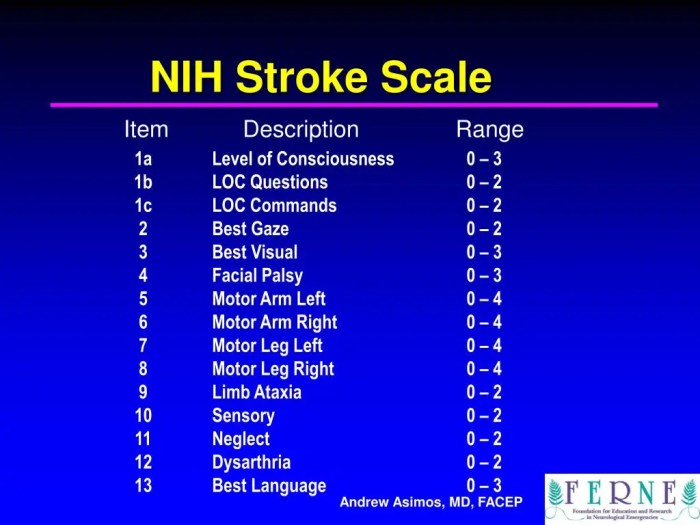Nih stroke scale answers group d – The NIH Stroke Scale (NIHSS) Group D answers provide crucial insights into the severity and prognosis of stroke. This scale, specifically designed for stroke assessment, helps clinicians evaluate various neurological functions and determine the appropriate treatment course.
Group D of the NIHSS focuses on specific components that assess consciousness, language, and attention. By examining these components, healthcare professionals can gain a comprehensive understanding of the patient’s neurological status and make informed decisions regarding their care.
1. Introduction: Nih Stroke Scale Answers Group D

The National Institutes of Health Stroke Scale (NIHSS) is a widely used clinical tool for assessing the severity of acute stroke. It provides a standardized method to evaluate various neurological deficits and quantify the extent of stroke-related impairment. The Group D component of the NIHSS specifically focuses on assessing speech and language function.
2. Components of Group D

Group D of the NIHSS comprises the following components:
- Speech
- Language
Speech
Speech is assessed based on the patient’s ability to repeat simple phrases, read aloud, and produce spontaneous speech. Possible responses include:
- Normal speech
- Slurred speech
- Dysarthria (difficulty articulating words)
- Aphasia (difficulty understanding or producing speech)
Language
Language is assessed by evaluating the patient’s comprehension and expression abilities. Possible responses include:
- Normal language
- Difficulty understanding speech
- Difficulty expressing thoughts or ideas
- Inability to speak or understand speech
3. Scoring System for Group D
Each component in Group D is assigned a score based on the patient’s performance:
| Component | Score |
|---|---|
| Normal speech | 0 |
| Slurred speech | 1 |
| Dysarthria | 2 |
| Aphasia | 3 |
| Difficulty understanding speech | 1 |
| Difficulty expressing thoughts or ideas | 2 |
| Inability to speak or understand speech | 3 |
The total score for Group D ranges from 0 to 6, with higher scores indicating more severe speech and language deficits.
4. Interpretation of Group D Results

The score obtained for Group D provides valuable insights into the severity of stroke-related speech and language impairments. Scores of:
- 0-1 indicate mild deficits that may not significantly impact communication.
- 2-3 suggest moderate deficits that may hinder effective communication and require speech therapy.
- 4-6 represent severe deficits that significantly impair communication and may require intensive rehabilitation.
Group D scores contribute to the overall NIHSS score, which guides prognosis, treatment decisions, and rehabilitation strategies for stroke patients.
5. Limitations and Considerations
While the NIHSS Group D is a valuable tool, it has certain limitations:
- It may not fully capture the nuances of speech and language impairments, particularly in non-native speakers.
- It requires trained personnel to administer and interpret the results accurately.
- Cultural and educational factors can influence the patient’s performance on the assessment.
To enhance the accuracy of Group D scoring, it is recommended to use the assessment in conjunction with other clinical evaluations and patient history.
Question & Answer Hub
What is the significance of Group D in the NIH Stroke Scale?
Group D specifically assesses consciousness, language, and attention, providing insights into the cognitive and neurological function of stroke patients.
How are points assigned in Group D?
Points are assigned based on the patient’s responses to specific questions and tasks within each component of Group D.
What are the implications of different Group D scores?
Higher scores indicate greater neurological impairment and are associated with more severe stroke outcomes, while lower scores suggest less severe impairment.